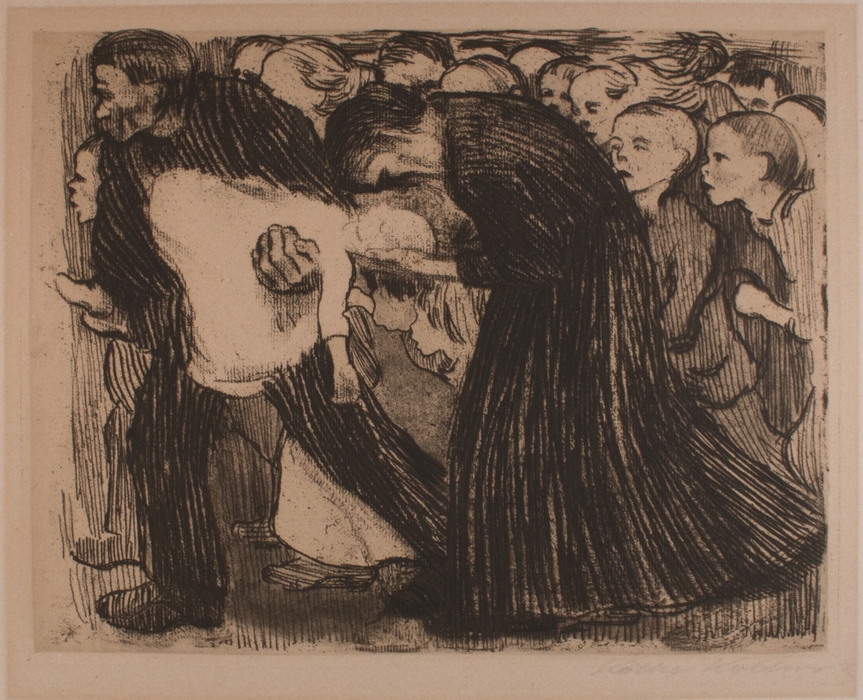
Käthe Kollwitz
(German, 1867–1945), Untitled (“Mob [Family] with Dead Child”), n.d., Dry point etching, Gift of Mrs. Ruth Funk, Cornell Fine Arts Museum 2001.04.09.PR
Where history provides perspective and comparison, art provides context and comfort. Historical art often provides both. That is why I have chosen Käthe Kollwitz’s Untitled (Mob [Family] with Dead Child) to feature this week, during these uncertain times. The art of printmaker and sculptor Käthe Kollwitz (1867-1945) – herself witness to some of the most tragic moments of the 20th century including World War I, the Great Depression, World War II and the Holocaust – resonates as strongly today as it did in her own time. The mastery of this etching is evident in the way it moves with ease from intense, closely knit crosshatching to the barest of line, expertly shaping the transition from light to dark (real and symbolic) while embodying the strongest of emotions. Compositionally, the father (holding a dead daughter in his arms) and the mother (following closely and holding her head) frame the small lifeless body, as if trying to protect the child with their own bodies.
The expression on their faces, however, leaves little doubt that there is nothing they – nothing any of us – can do now. The parents are, in turn, surrounded by other children and a few adults, possibly extended family members. All wear sadness and grief on their faces. The greatest contrast is also the compositional center of the image: the mother’s bent head, parallel to that of the dead child. While the mother’s face, framed by her black hair and dress, is executed in dark tones, her features unambiguously strained by pain, the child’s face is light, with a barely drawn contour, her not-quite-visible features peaceful, as if asleep. The message is overwhelmingly, painfully simple: we mourn the death of the innocent, of those who cannot protect themselves, who are often the first to die. Characteristic of the artist’s oeuvre, the emphasis is on people: there is no surrounding landscape, no indication of a place or time. The subject is human grief, the message universal: it can happen anywhere, to anybody. We are confronted and called to empathize with the loss of a child, arguably the greatest loss a person can suffer.
And while the message is universal, it is also personal: Kollwitz had lost her son Peter on the battlefields of World War I, when he was only 18. In subsequent years, she created a large body of graphic works as well as sculptures, diary and letters that express not only a mother’s intense grief, but also the inner turmoil, the uncertainty, the questions about the meaning of sacrifice in war with which she struggled for many years after. This undated etching may be depicting the effects of war, or those of the Great Depression, the famine and poverty that dominated so much of the early 20th century in Europe. Either way, the image is that of shared loss and shared humanity: its strength lies in the masterful composition and the artist’s ability to makes us feel similar emotions. This is precisely why our museums are places of refuge during hard times. Art allows us to enter other times and lives, to reflect upon universal feelings and share in sadness and happiness alike. And in the process, we find strength for what we experience today and what we may face tomorrow.
Ena Heller, Ph.D.
Bruce A. Beal Director
See this work by Käthe Kollwitz on our Collection page.
